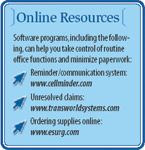Article
Are you managing paperwork or is it managing you?
When it comes to the business side of medicine, managers and physicians are irritated by the flow of paper in their office and the major investment of time and money required to manage it. So much for the paperless office!
When it comes to the business side of medicine, managers and physicians are irritated by the flow of paper in their office and the major investment of time and money required to manage it. So much for the paperless office!

Incoming!

Internal paper
Now it's time to examine your recall system. New virtual communication systems are available that not only send appointment reminders to patients, but that also track cancellations and notify patients who want an earlier appointment date. Integrating this type of system not only reduces paperwork, but the cost is a fraction of what you currently spend on staff time. It also reduces gaps in your schedule and pumps up revenue.
More often than not, I discover practices are still photocopying patients' insurance cards, although a card scanner accomplishes this far more efficiently. Most practice management software systems enable you to import insurance card information directly onto the computer.
Periodically examine your charting system. Are you filing things in patient charts that you don't need or that duplicates information you already have? Are you storing charge tickets or old copies of patient registration forms? Stop it. Once the charge ticket is posted, it should be scanned into a separate depository on your computer where daily batches are maintained. Then destroy the paper copy.
Are you storing medical records from your patients' prior physicians inside their charts? If so, set up guidelines for what information should be kept, such as a record of their medications and the latest year's treatment. Once you have established a policy, when you are requesting past medical records, let the doctor know specifically what information you want. It will save both of you time and money.
Take a critical look at medical records to see what else you might want to eliminate, such as business communication. If you're unsure of what correspondence can be safely discarded, check with your accountant. If you're unsure of what medical information should be saved and what can be eliminated, your malpractice insurance carrier can advise you on risk-protecting your practice.
When it comes to medical records, an electronic medical records system, sometimes referred to as an electronic health records (EHR) system, is the best solution. With close examination, you'll likely discover that there is little need for paper charts: All documentation can be scanned into the EHR system.
As to forms, many practices have discovered that they are better off by scanning or creating necessary forms onto the computer system and printing them as needed.
Billing and inventory
Paperwork in the billing department can be reduced in a number of ways.
First, if you are receiving payments in your office and filing the explanations of benefits, get a bank lock box. This means all the payments go directly to the bank and are deposited in your account. The bank will send an electronic record of the deposit, the checks, and the EOBs for each transaction, and you can post the payments on your system.





